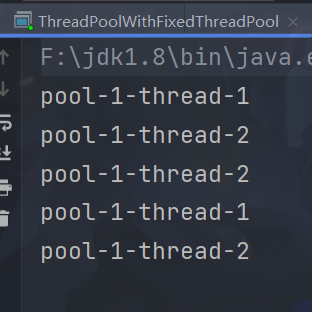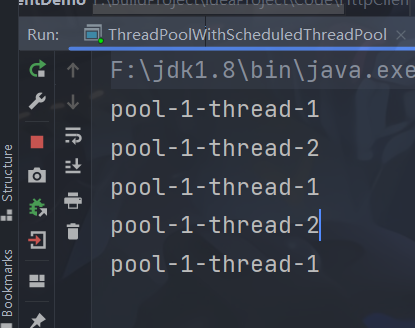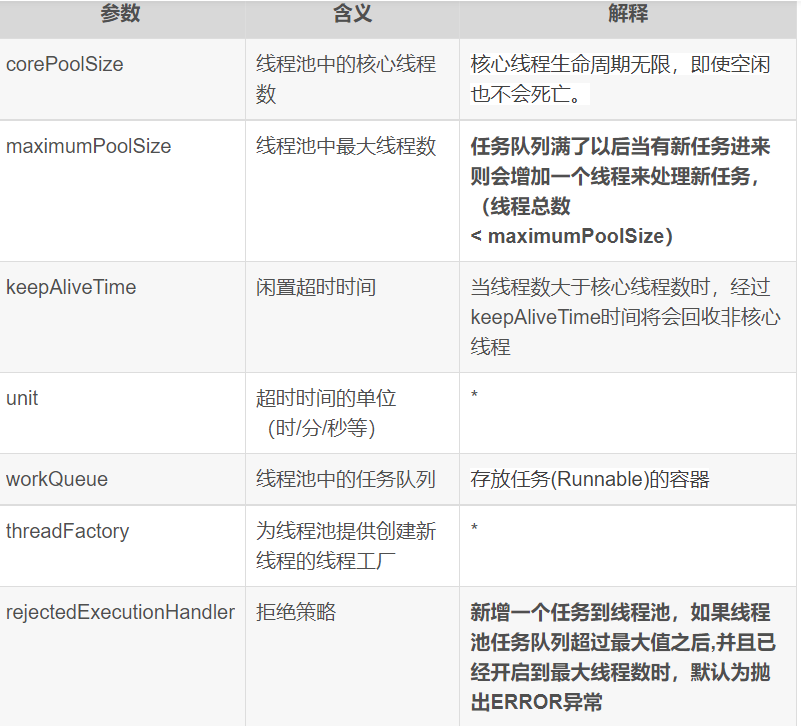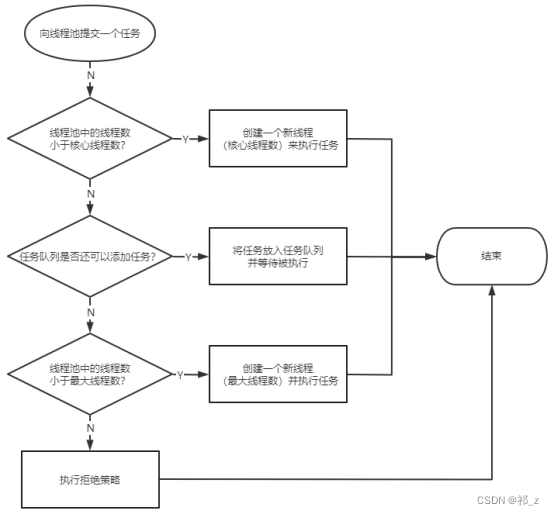Java线程池
简介
线程池介绍
线程池(thread pool):一种线程使用模式。线程过多会带来调度开销,进而影响缓存局部性和整体性能。而线程池维护着多个线程,对线程统一管理。
线程池就是存放线程的池子,池子里存放了很多可以复用的线程。
创建线程和销毁线程的花销是比较大的(手动new Thread 类),创建和消耗线程的时间有可能比处理业务的时间还要长。这样频繁的创建线程和销毁线程是比较消耗资源的。(我们可以把创建和销毁的线程的过程去掉)。
使用线程池的优势
提高效率,创建好一定数量的线程放在池中,等需要使用的时候就从池中拿一个,这要比需要的时候创建一个线程对象要快的多。
减少了创建和销毁线程的次数,每个工作线程都可以被重复利用,可执行多个任务。
提升系统响应速度,假如创建线程用的时间为T1,执行任务用的时间为T2,销毁线程用的时间为T3,那么使用线程池就免去了T1和T3的时间;
四种创建线程池的方式
Executors类(并发包)提供了4种创建线程池方法,这些方法最终都是通过配置ThreadPoolExecutor的不同参数,来达到不同的线程管理效果。
newCacheTreadPool
创建一个可以缓存的线程池,如果线程池长度超过处理需要,可以灵活回收空闲线程,没回收的话就新建线程
newFixedThread
创建一个定长的线程池,可控制最大并发数,超出的线程进行队列等待。
newScheduleThreadPool
可以创建定长的、支持定时任务,周期任务执行。
newSingleExecutor
创建一个单线程池,它只会用唯一的工作线程来执行任务,保证所有任务按照指定顺序(FIFO, LIFO, 优先级)执行。
newCacheTreadPool的创建与使用
创建一个可以缓存的线程池,如果线程池长度超过处理需要,可以灵活回收空闲线程,没回收的话就新建线程。
总结: 线程池的最大核心线程为无限大,当执行第二个任务时第一个任务已经完成,则会复用执行第一个任务的线程;如果第一个线程任务还没有完成则会新建一个线程。
public class ThreadPoolDemo {
public static void main(String[] args) {
ExecutorService cachedThreadPool = Executors.newCachedThreadPool();
Runnable runnable = null;
for (int i = 0; i < 5; i++) {
runnable = ()->{
try {
Thread.sleep(10);
} catch (InterruptedException e) {
throw new RuntimeException(e);
}
System.out.println(Thread.currentThread().getName());
};
cachedThreadPool.execute(runnable);
}
}
}

newFixedThreadPool创建与使用
创建一个定长的线程池,可控制最大并发数,超出的线程进行队列等待。
总结:创建指定长度的线程池,任务超出当前线程池执行线程数量则会一直等待,直到运行。
package com.mrs.interview.STread;
import java.util.concurrent.ExecutorService;
import java.util.concurrent.Executors;
/**
* 创建一个定长的线程池,可控制最大并发数,超出的线程进行队列等待。
* description: ThreadPoolWithFixedThreadPool
* date: 2022/10/27 12:07
* author: MR.孙
*/
public class ThreadPoolWithFixedThreadPool {
public static void main(String[] args) {
// 创建定长线程池
ExecutorService fixedThreadPool = Executors.newFixedThreadPool(2);
Runnable runnable = null;
for (int i = 0; i < 5; i++) {
runnable = ()->{
//实现Runnable接口中的run方法
//创建任务
try {
Thread.sleep(10);
} catch (InterruptedException e) {
throw new RuntimeException(e);
}
System.out.println(Thread.currentThread().getName());
};
//将任务交给线程池管理
fixedThreadPool.execute(runnable);
}
}
}

newScheduledThreadPool
创建定长的、支持定时任务,周期任务执行
总结:以下案例中延迟2秒后开始执行线程池中的所有任务。
package com.mrs.interview.STread;
import java.util.concurrent.Executors;
import java.util.concurrent.ScheduledExecutorService;
import java.util.concurrent.TimeUnit;
public class ThreadPoolWithScheduledThreadPool {
//以下案例中延迟2秒后开始执行线程池中的所有任务
public static void main(String[] args) {
ScheduledExecutorService scheduledThreadPool = Executors.newScheduledThreadPool(2);
Runnable runnable = null;
for (int i = 0; i < 5; i++) {
runnable = ()->{
System.out.println(Thread.currentThread().getName());
};
//将任务交给线程池管理, 延迟2秒后才开始执行线程中的所有任务
scheduledThreadPool.schedule(runnable, 2, TimeUnit.SECONDS);
}
}
}

newSingleExecutor
创建一个单线程池,它只会用唯一的工作线程来执行任务,保证所有任务按照指定顺序(FIFO, LIFO, 优先级)执行。
package com.mrs.interview.STread;
import java.util.concurrent.ExecutorService;
import java.util.concurrent.Executors;
/**
* description: ThreadPoolWithSingleThreadPool
* date: 2022/10/27 12:29
* author: MR.孙
*/
public class ThreadPoolWithSingleThreadPool {
public static void main(String[] args) {
// 创建单线程-线程池,任务依次执行
ExecutorService singleThreadExecutor = Executors.newSingleThreadExecutor();
Runnable runnable = null;
for (int i = 0; i < 5; i++) {
//创建任务
runnable = ()->{
System.out.println(Thread.currentThread().getName());
};
//将任务交给线程池管理
singleThreadExecutor.execute(runnable);
}
}
}

推荐多线程用法
推荐通过 new ThreadPoolExecutor() 的写法创建线程池,这样写线程数量更灵活,开发中多数用这个类创建线程。
ThreadPoolExecutor核心参数:
public ThreadPoolExecutor(int corePoolSize,
int maximumPoolSize,
long keepAliveTime,
TimeUnit unit,
BlockingQueue<Runnable> workQueue,
ThreadFactory threadFactory,
RejectedExecutionHandler handler)

线程池的工作原理

多线程四种拒绝策略
这四种拒绝策略,在ThreadPoolExecutor是四个内部类。
AbortPolicy abortPolicy = new ThreadPoolExecutor.AbortPolicy();
DiscardPolicy discardPolicy = new ThreadPoolExecutor.DiscardPolicy();
DiscardOldestPolicy discardOldestPolicy =
new ThreadPoolExecutor.DiscardOldestPolicy();
CallerRunsPolicy callerRunsPolicy = new ThreadPoolExecutor.CallerRunsPolicy();
- AbortPolicy
当任务添加到线程池中被拒绝时,直接丢弃任务,并抛出
RejectedExecutionException异常。
- DiscardPolicy
当任务添加到线程池中被拒绝时,丢弃被拒绝的任务,不抛异常。
- DiscardOldestPolicy
当任务添加到线程池中被拒绝时,丢弃任务队列中最旧的未处理任务,然后将被拒绝的任务添加到等待队列中。
- CallerRunsPolicy
被拒绝任务的处理程序,直接在execute方法的调用线程中运行被拒绝的任务。
总结:就是被拒绝的任务,直接在主线程中运行,不再进入线程池。
CallerRunsPolicy这种方式好多同学可能不太理解,这里给大家看个Demo:
package com.mrs.interview.STread;
import java.util.concurrent.LinkedBlockingDeque;
import java.util.concurrent.ThreadPoolExecutor;
import java.util.concurrent.TimeUnit;
/**
* description: CallerRunsPolicyDemo
* date: 2022/10/27 12:49
* author: MR.孙
*/
public class CallerRunsPolicyDemo {
public static void main(String[] args) {
// 创建单线程-线程池, 任务依次执行
ThreadPoolExecutor threadPoolExecutor = new ThreadPoolExecutor(2, 2, 260, TimeUnit.SECONDS,
new LinkedBlockingDeque<>(2), new ThreadPoolExecutor.CallerRunsPolicy());
for (int i = 0; i < 10; i++) {
Runnable runnable = new Runnable() {
@Override
public void run() {
try {
Thread.sleep(20);
} catch (InterruptedException e) {
throw new RuntimeException(e);
}
System.out.println(Thread.currentThread().getName());
}
};
threadPoolExecutor.execute(runnable);
}
}
}

被拒绝的任务直接在主线程中进行



 浙公网安备 33010602011771号
浙公网安备 33010602011771号